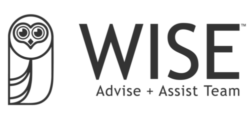9 Steps to Improve Your Email Marketing!
Written By: Lauren Shuman, WISE Digital Marketing Specialist
Large companies and small businesses alike can see significant results from email marketing. It’s an effective and affordable way to communicate with potential customers and clients. However, we all have tons of emails filling up our inboxes. Since just about every single company sends out emails, there are so many messages that go unread and unclicked.
That’s why an email marketing strategy is key to higher open rates.
While it’s true that email is a welcome place to see marketing messages because your audience has opted in and agreed to receive your emails, people don’t join email lists for nothing. They expect something in return, whether that’s a sweet discount, useful resources, or access to exclusive information. If the value your email provides them doesn’t outweigh the annoyance of yet another email, they’re going to unsubscribe.
How well is your brand cutting through all the digital clutter? The following steps will ensure that your email marketing efforts resonate with your audience and get you results.
1. Make a Plan
Before you dive in, you need a plan. What are you trying to achieve with your emails — website visits? Sales? Brand awareness? Event registrations? What message does your audience need, and when? Once you’ve identified your objective and timing, work backwards from that end goal.
Use a calendar to organize your email schedule each month, and factor in important dates like product launches, events, holidays, or promotions. Also, be mindful of the frequency. Emailing your audience too often will annoy them. Your goal is to keep your brand at the top of their mind with the right messaging at the right time.
2. Build Your Audience Using Lead Magnets
If you don’t already have a database full of customer emails, lead magnets are a great way to build your list. A lead magnet is something you offer for free in exchange for someone’s email. These often come in the form of a free download, webinar, guide, toolkit, training, or other digital resource. This is a good way to introduce your brand to a potential customer by providing something of value to them, while also collecting their information and enabling you to nurture that lead.
3. Segment Your Audience
Most email platforms have options to tag, segment, or group your contacts, which can help you personalize your email content and send people only what’s relevant to them.
The more you know about your contacts, the better you can segment them. Ask questions on your lead or opt-in form to help you with this. For example, if you’re in the real estate industry, it may be helpful to ask people if they’re a realtor, homeowner, or renter, as this will affect the type of message you send these individuals. You can segment your audience by interests, purchases, location, job title or industry, or by which lead form they used. Each company is different, so find what kind of segmentation is appropriate for your brand and your customers.
From there, incorporate it into your email schedule. It’s better to send different emails to different segments than to bug your entire list with irrelevant messages. By segmenting and personalizing your emails, you’ll see fewer unsubscribes and higher conversion rates.
4. Write Your Email Content
You already know the primary objective of your email, so start by crafting copy to convey this message. Avoid language that is salesy or spammy, and be concise. The longer an email is, the less likely people are to read through it all. Your message should focus on your audience’s pain points, and show that you understand them and have a solution. Provide resources, discounts, entertainment, or something that will benefit your audience. They’ll be more likely to open your emails if you consistently provide value to them.
5. Design Your Email
Your email design should be clean and simple. Using headers, subheaders, visuals, and dividers helps guide readers through your email and breaks up the text. Choose fonts that are easy to read, and make your calls to action (CTAs) stand out by using boldly colored buttons.
Your primary headline and message should be visible “above the fold”, where someone can see it without scrolling down. People should be able to quickly skim your email to figure out what it’s about.
6. Write Subject Lines and Preview Text
Your subject line is often what makes someone decide to open (or not open) an email, so these few words are important. Your subject line strategy may vary depending on your brand’s voice and tone, but keep it short and concise. Tell them how they’ll benefit from what’s inside, or use a question or cliffhanger to entice curiosity. Be sure to use the preview text to your advantage too, which appears next to or beneath the subject line.
7. Check Everything Twice, Then Hit “Send”!
You should always send yourself a test email before sending it to your entire audience. Sometimes your email will look a little different when it’s actually in your inbox. Make sure it looks good on both desktop and mobile devices, as well as on different browsers and email servers. Test all of your CTA buttons and links, check for typos, and send it to a peer for a fresh set of eyes. Then, when you’re ready, send it! This is the fun (and scary) part!
8. A/B Test
One of the strengths of digital marketing is the ability to conduct A/B tests. Test out different subject lines, send times, or content (only test one variable at a time), and pay attention to the results. Monitor your open and click-through rates, unsubscribes, conversions, and other key indicators, then adjust your email strategy accordingly.
No amount of information you read online can replace the insights you gain from your own analytics. Every business is different, so there’s no substitute for actually knowing your audience, and A/B testing is the way you get to know them.
9. Automate
Once you’ve established a solid strategy, set up automations, or sequences of emails that go out when audience members complete an action such as downloading a brochure or completing a purchase. This is a great way to save time while meeting your customers’ needs. Check out our recent blog post about email automation to learn more.
These nine steps to improve your email marketing are guaranteed to get you noticed amongst the digital clutter so prevalent in inboxes today. Set yourself up for success by implementing a few at a time and see how your click results soar!
Bogged down by email marketing? Don’t have time to set everything up? Hire a WISE expert today! https://wiseadviseteam.com/contact/

